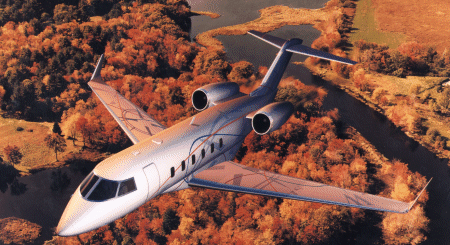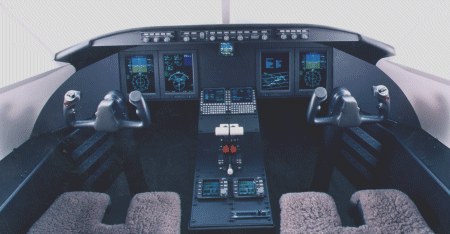Bombardier says its 'super mid-size' business jet would cost $4 million more if made by anyone else - but it has not skimped on its systems
Graham Warwick/WASHINGTON DC

Bombardier's Continental may be the first business jet designed to a price point, but it has the specification of a more expensive aircraft. Using its experience with risk-sharing programmes, the Canadian company has put a price tag of less than $15 million on a "super mid-size" business jet it believes would cost up to $19 million if produced by another manufacturer.
Bombardier, which has introduced a new aircraft every year since 1991, has also used its accumulated development expertise to shorten the cycle time from launch to certification to just 40 months. This has allowed the company to delay defining its aircraft until the other players in the super mid-size market have played their hands - and still get the aircraft to market in a competitive timeframe.
"We are the only manufacturer who can pull this together," says Continental product director Claude Chidiac. "We had a not-to-exceed price point to design to-and we have the design expertise, development skills and economies of scale to achieve it."
The Continental is the product of the most extensive market research Bombardier has ever conducted. The result, says Chidiac, is that the aircraft is designed not so much to exceed the competitors' specifications, but as to provide the features operators say they want.
Surveys of operators of existing mid-size business jets quickly produced a consensus on their requirements, he says. They wanted true US coast-to-coast range, the ability to operate from 1,520m (5,000ft) or smaller runways, a price tag of less than $15 million, a true eight-passenger cabin and a Mach 0.8 cruise speed. "Balance was most important," says Chidiac. "They wanted an aircraft that would do everything well, and not excel in one area at the expense of another."
The resulting Continental has a range of 5,750km (3,100nm) with eight passengers and two crew. Balanced field length at the 17,000kg (37,500lb) maximum take-off weight is 1,510m. Initial cruise altitude is 41,000ft (12,500m) , at up to ISA+10ºC, and maximum altitude is 45,000ft. Long-range cruise speed is M0.8 and maximum cruise M0.82. Current price is $14.25 million including standard interior, and direct operating costs are $770/h.
Arguing that mid-size aircraft are not reliably transcontinental, Chidiac says operators now must step from a $10-12 million mid-size aircraft to a $17-20 million large business jet to gain the 5,500km range required to guarantee UScoast-to-coast capability in all conditions. The Continental is designed to fly transcontinental "every day, with a full passenger load, without sacrificing speed", he says, at an "incremental" step up in price from today's mid-size jets.

Cabin comfort is also an issue in mid-size business jets, says Chidiac, and customer focus groups were called in to view cabins ranging from 1.9m to 2.3m (75-93in) wide, and of various lengths. The cabin selected is 2.18m wide and 1.85m high, with a 1.55m wide flat floor and a 5.03m long seated area. The basic configuration provides double-club seating for eight, with galley forward and toilet aft, and a 3.1m3 (110ft3) aft baggage hold that is accessible from the cabin.
The cabin is also well appointed: standard equipment includes microwave oven, coffee maker, CD player, Airshow 400 flight information displays and Magnastar 2000 airborne telephones.
System sophistication has not been compromised by Bombardier's design-to-cost philosophy, says Chidiac. The standard aircraft is fully equipped for US transcontinental missions, he says, with provision for easy installation of the optional systems required for intercontinental missions. The baseline fit includes enhanced ground proximity warning and traffic alert and collision avoidance systems to improve safety, as well as the 8.33kHz VHF channel spacing and reduced vertical separation minima capabilities essential in Europe.
Bombardier's experience in running a business jet fractional ownership programme shows in the design of the systems. "This is the first aircraft we have designed since entering the fractional ownership market," says Chidiac. Fractional use is even more demanding than airline operation, he says. "If an airliner fails, it will be at a hub where there are spares and support. A fractional aircraft can end up anywhere. If it fails, they can't count on spares being available."
Such factors have driven efforts to increase the Continental's despatch reliability and reduce its operating costs. To achieve the reliability goals, proven systems are used and suppliers are required to design their systems to allow despatch with one component failed. Replacement of any line-replaceable unit must take 20min or less - a requirement Bombardier has brought over from its regional airliners.
Bombardier has driven operating costs down by negotiating maintenance cost guarantees with its suppliers. The target of $770/h - substantially lower than for the Continental's nearest competitor - is achieved largely through savings on engine maintenance costs. "We picked AlliedSignal's AS907 because it offered more value in the aircraft," says Chidiac. "It's a low-risk design, and highly derated. It makes the largest difference to the operating cost."
Essentially the same engine is expected to have been flying for about a year on British Aerospace's re-engined Avro RJ-X regional airliner by the time the Continental begins flying, giving Bombardier confidence that the all-new AS907 will meet its performance and maintenance guarantees.
Chidiac says Bombardier convinced its risk- and revenue-sharing partners, such as AlliedSignal, that reducing component prices would pay off in increased aircraft sales and greater aftermarket business. As a result, the company has negotiated lower prices for even off-the-shelf systems, such as the AlliedSignal auxiliary power unit, which is also used in the more expensive Cessna Citation X and Raytheon Hawker Horizon super mid-size business jets.
There is more to design-to-cost than setting a not-to-exceed price, he says. "Ownership cost is the driver. That means acquisition and operating costs have to be low and residual value has to be high." Concerns over the potential impact on residual value drove Bombardier away from using any advanced technology, such as a composite fuselage, he says. "We are not exploring any new technology."
Bombardier has refined its approach to risk sharing for the Continental, inviting preferred partners from previous programmes to participate at an earlier stage. This helped compress the development schedule, says Chidiac. During the nine-month joint concept definition phase (JCDP), completed in May, the preferred partners helped Bombardier draw up the technical specification for the aircraft. They were then invited to bid to become risk-sharing partners in the programme.
Most, but not all, of the companies that took part in the JCDP made it through to the six-month joint definition phase (JDP) now under way. During this phase, the partners and Bombardier will work together in Montreal to define the interfaces between their parts of the aircraft. After completion of the JDP in November, the partners will return home to complete detail design.
The supercritical-section wing, conceived by Bombardier, will be produced by Mitsubishi Heavy Industries. The cockpit will be produced by Bombardier's Canadair division in Montreal, the centre fuselage by its Shorts division in Northern Ireland, and the aft fuselage and vertical and horizontal stabilisers by a new partner, AIDC in Taiwan. Final assembly will be at Bombardier's Learjet division in Wichita, Kansas, and completion at the company's site in Tucson, Arizona.
Hawker de Havilland of Australia will provide the APU installation kit and quick-access tailcone, while Fischer of Austria will supply the composite belly fairing. AlliedSignal will provide the complete powerplant, including the nacelle supplied by GKN Westland Aerospace and thrust reverser from Hurel-Dubois.

System partners include Rockwell-Collins providing its Pro Line 21 integrated avionics with four large flat-panel displays; ECE (electrical); Intertechnique (fuel); Liebherr (flap controls, environmental and pressurisation control and anti-ice); Messier Dowty (landing gear); Moog (secondary flight controls); and Parker Abex (hydraulics). Bombardier itself will provide the primary flight controls.
The first of five flight test aircraft is scheduled to fly in June 2001, leading to certification in September 2002 and the first "green" delivery three months later. Chidiac says Bombardier and its partners will gear up to produce up to 58 Continentals a year.
When it enters service, the aircraft will fill a niche between Bombardier's $11.4 million mid-size Learjet 60 and $21.8 million Challenger 604 large business jet. The Continental will be Bombardier's third all-new business jet - and its 11th new aircraft since 1991.
Source: Flight International























